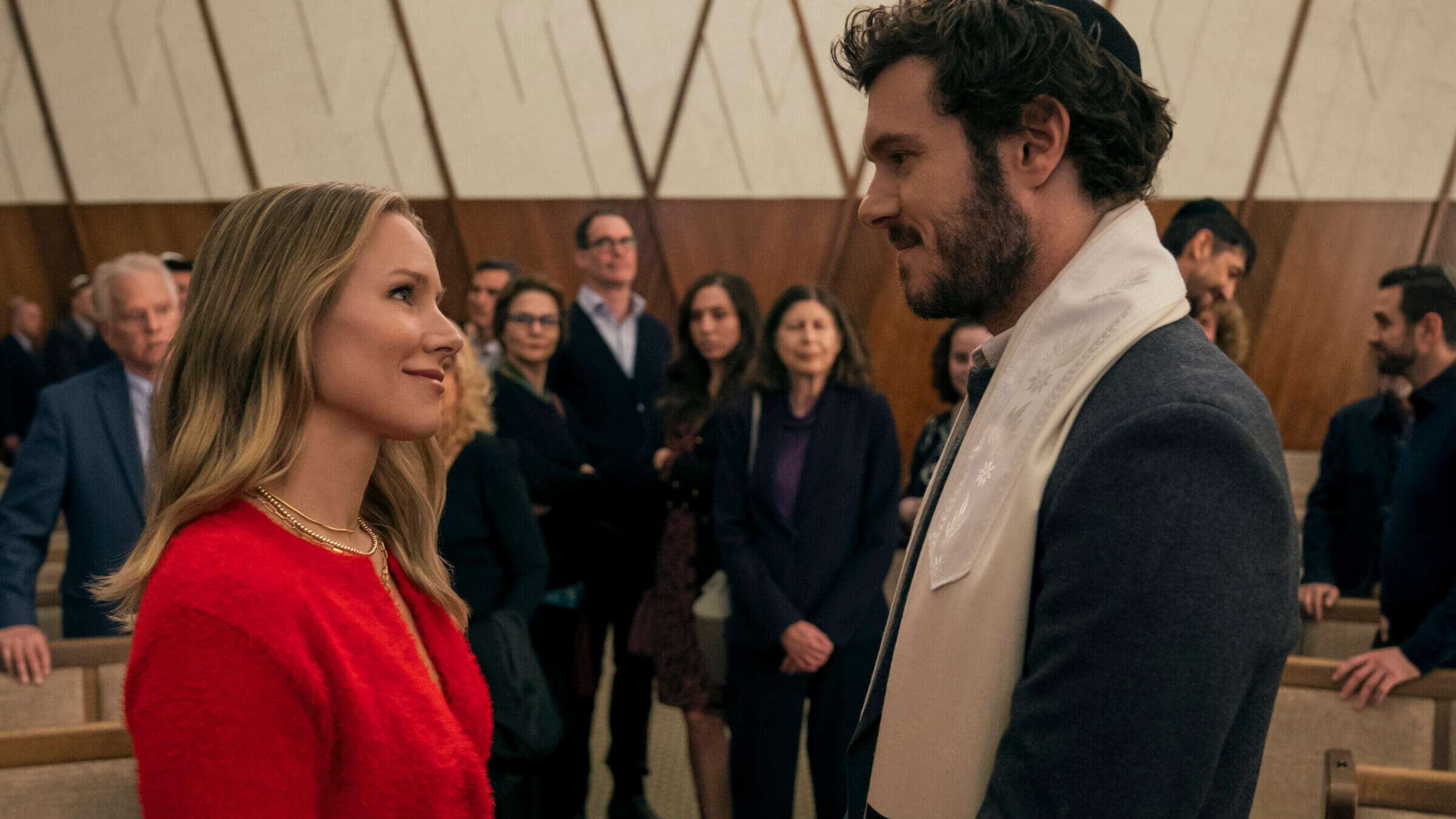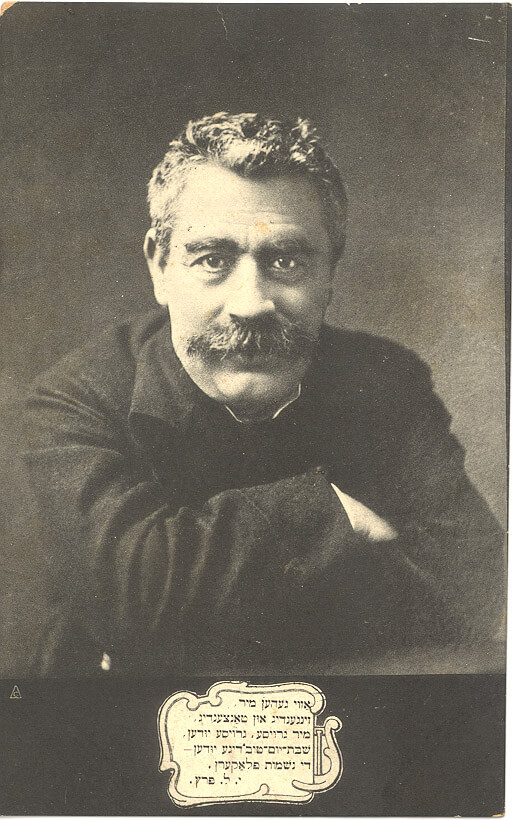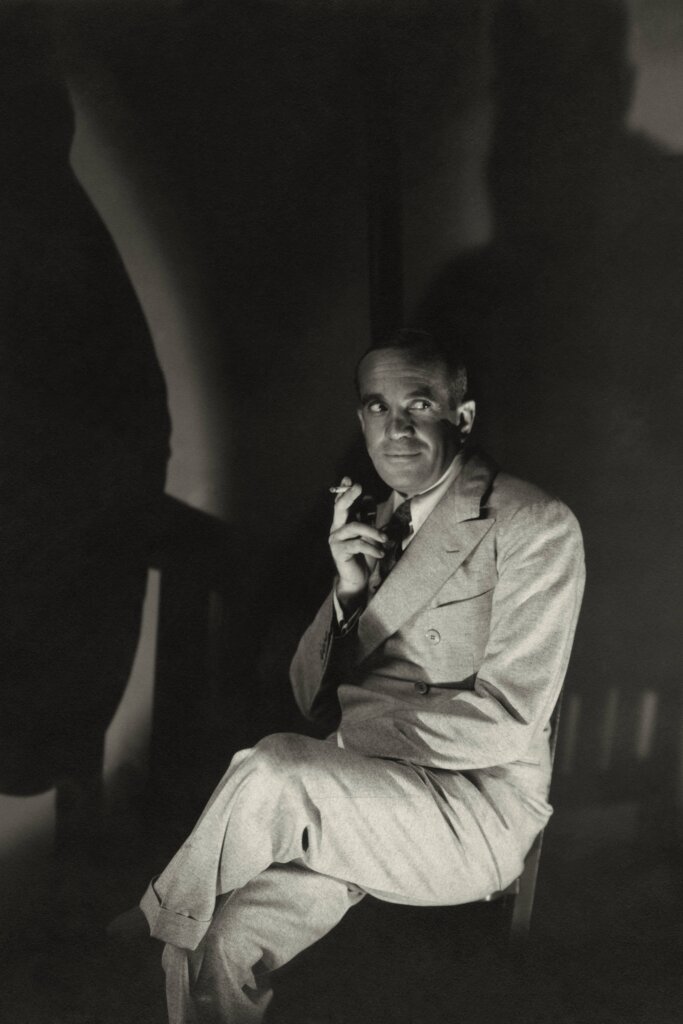Why the hot rabbi is having a moment (again)
Adam Brody is set to play a religious leader with sex appeal — he isn’t the first

Adam Brody and Kristen Bell in Nobody Wants This. Photo by Stefania Rosini/Netflix
Nobody asked for it, but it seems we are headed into a Hot Rabbi Autumn just in time for the High Holidays.
At the end of September, Netflix is releasing the series Nobody Wants This, where Adam Brody will play an “unconventional rabbi” named Noah. The main convention he seems to be breaking, at least for Hollywood, is having swoony good looks.
“You’re the rabbi?” Kristen Bell’s character, a podcaster “without a Jewish bone in her body,” says with evident surprise during their meet cute at a party.
“Hot, right?” he replies. Later, some bat mitzvah-age girls will refer to him, a la kosher Fleabag, as “Hot Rabbi.”
He is far from the first.
There is a long history of hot rabbis on our pages and screens dating back to the dawn of the rabbinic tradition. There are manhood-measuring contests in the Talmud, smolder-eyed gazes from young Hasidic leaders in Yiddish literature and Ben Stiller as a very eligible junior rabbi in a cult hit rom-com.
We can learn a lot by asking why, given this tradition, acknowledging members of the rabbinate as attractive still feels somewhat subversive. It has more to do with cultural expectations, and less to do with who actually heads Jewish congregations today.
Sexy rabbis may be having a renewal, reflective of the world today, but to paraphrase the sages, the work to normalize this hotness is not yet complete — we are not obligated to finish it, but neither are we free to abandon it.
The dawn of the hot rabbi
Midrash recounts the exquisite beauty of many of the patriarchs and matriarchs, and Moshe Rabbeinu — in a verse garbled in translation by Saint Jerome — was said to glow with glory on transmitting the Law to the Israelites in the desert. But in the rabbinic period proper, which can generally be dated to the Second Century after the destruction of the Second Temple, there was one rabbi hotter than the rest.
“I alone remain of the beautiful people of Jerusalem,” said Rabbi Yohanan, a Second Century rabbi from Galilee, whose reputation as a Jerusalem 10 is regularly touted in the Talmud.
How hot was he? According to him, if you were to acquire a brand new silver goblet, fill it with pomegranate seeds, place a diadem of red roses around the vessel and place it between sunlight and shade, its resulting luster would be “a semblance of Yohanan’s beauty.”
@miriamanzovin Shalom friends! Welcome to #DafReactions Bava Metzia 84: The Real Beauty Queen of Jerusalem Bridgerton can sit down and hold my 🍺. Let me tell you the epic, tragic love story of the beautiful Rabbi Yochanan, and bad boy of the #Talmud Reish Lakish. #DafYomi ♬ original sound - Miriam Anzovin
The Talmud discourses further about Yohanan’s hotness (“the beauty of Rav Kahana is a semblance of the beauty of Rabbi Abbahu; the beauty of Rabbi Abbahu is a semblance of the beauty of Jacob, our forefather; and the beauty of Jacob, our forefather, is a semblance of the beauty of Adam the first man,” and so on). Yohanan, the text says, can’t be included in this list because he didn’t have a beard.
“The Gemara is beard-shaming him,” said Miriam Anzovin, who runs a social media account reacting to the daily Daf, or page-a-day of Talmud. (Anzovin says no beard is her own preference.)
In her videos, Anzovin often refers to Yohanan as a “legendary hottie” and jokes about how, in the current century, he might have been a beauty influencer with his own brand of lash serum.
It is perhaps because of Yohanan’s lack of a beard that his beauty had a thread of androgyny.
One anecdote Anzovin shared has Yohanan and Resh Lakish, a bandit who later devoted his life to Torah, bathing together in the Jordan River, where Lakish tells him, “Your beauty is fit for a woman.” Lakish was either saying that a woman would like to possess his comeliness, possess him personally, or maybe, in a sort of reverse-Mulan-bath-scene scenario, was under the mistaken impression that Yohanan was himself a lady.
Yohanan uses this compliment, as any good rabbi might, to encourage Lakish to reform his ways — saying his sister is even hotter, and if Lakish commits himself to Torah he can make a shidduch. (Reader, she married him.)
Despite his looks, Yohanan would likely be regarded quite differently today, if only because he used to hang around outside a mikvah so women leaving it to have sex with their husbands would see him and, through witnessing his sheer hotness, conceive nice-looking babies.
Discussing Yohanan, Anzovin sees a double standard, recalling Miriam Shapira-Luria, a Talmud teacher from the Middle Ages. She taught behind a screen so people wouldn’t be distracted by her beauty. Yohanan had no such qualms.
“For a woman, it’s more like, ‘Mmm, I don’t think I can learn from her. She’s probably a whore,’” Anzovin said of the reaction to women teachers. Since she started posting her Daf Reaction TikToks in 2022, Anzovin has received a similar sentiment from many Jewish men reluctant to listen to a woman talking Talmud.
“I kept being like, ‘I beg your pardon, would you say that to Rabbi Yohanan?’ Or is it not that you think I’m attractive, it’s because I’m a woman.”
It’s unlikely that anyone would raise the issue about Yohanan, or even dispute his own reporting on his hotness.
“You rarely have agreement in the Talmud about anything,” Anzovin said, but there is more or less consensus about Yohanan that, aside from the beard issue, he is “super gorgeous.”
In Yiddish lit, the hot rabbis were Hasidic
When I asked Miriam Udel, a Yiddish scholar and one of the first Orthodox women to be ordained as a rabbi, about hip, young (and potentially hot) rabbis, she thought immediately of the work of I.L. Peretz.
Peretz, who wrote in the late 19th and early 20th century, was enamored of the rising Hasidic movement in Eastern Europe and chose to write about charismatic Hasidic rabbis revitalizing what had become a hidebound form of faith.

In his story “Between Two Mountains,” a young rabbi named Noah (like Brody’s character on the Netflix show?!) leaves his mentor in Brisk to become the rabbi of Biale. The narrator, a follower, recalls him as short and thin with a black beard and black, curly peyos, whereas his elder, the Rabbi of Brisk, has a white beard and terrifying eyebrows that elicit “fear and trembling.”
His disciple reports that Noah’s eyes “shine so kindly and gently that it enlivens your heart when he throws you a glance,” that his voice is “velvet-sweet” and “caresses your heart so delightfully.” His overall effect is to dissolve your soul with love and even make it wish to depart from the body “like a butterfly drawn to a bright flame.”
The Rabbi of Biale charges that the Rabbi of Brisk’s Torah is “all judgment,” missing its spark and reserved for scholars. Their two approaches speak to a theme in much of hot rabbi media — the old rabbi and the new one, with the younger generation bringing new energy to an ancient faith.
“There’s always going to be this contest between the stodgy and the new, and there’s always going to be a question of attunement and who’s attuned to the Jews in the pews,” said Udel. “It’s often more spirituality or an ability to connect with people.”
In other words, a “relatable rabbi.”
There are other variations in the Yiddish canon, including the teacher-student relationship between Fefferl (better known as Perchik to musical fans) and Hodl in Sholem Aleichem’s Tevye and his Daughters. While not a rabbi, Fefferl/Perchik serves as a titillating introduction to new ideas, in his case Marxist ones.
Ab Cahan’s stories of New York’s Jewish ghetto, meanwhile, often present young Torah scholars who, while not pulpit rabbis, end up winning over young women with their intelligence, and, in their way, integrate the Old World and the new, a motif for most contemporary tales of sexy Jewish clergy.
Too hot for TV (or film)

Behind nearly every onscreen depiction of an attractive rabbi is a paradigm shift.
Samantha Pickette, author of , recalls an iconic visual metaphor in the first talkie, 1927’s The Jazz Singer starring Al Jolson, in a largely autobiographical story.
Filling in for his dying cantor father on Kol Nidre, Jolson’s Jakie Rabinowitz sings on the bimah. He is clean-shaven, young and almost completely assimilated. Behind him appears the ghost of his bearded, Old World immigrant father. The montage hints at continuity, but also shows a distinct division.
For many years after Jolson, when rabbis turned up in pop culture, they looked more like Jolson’s father than Jolson.
“They’re portrayed either as these very old, traditional limiting figures who try to restrict a protagonist’s movement into modernity or whatever it is they’re trying to strive for,” said Pickette. “Or they, you know, are kind of these laughable, unhelpful buffoons who don’t really have much in the way of spiritual leadership.”
But there have been a few exceptions. Pickette loves Eli Wallach’s character, Rabbi Aaron Gold in Claudia Weil’s 1978 film Girlfriends.
Wallach, while an older man, doesn’t have a beard or even always wear a kippah. He is a sexual being, beginning an affair with Melanie Mayron’s character, a young photographer. He is uniquely approachable and shares with her that he had initially wanted to become an actor and charms her by miming like Marcel Marceau.
Pickette views Wallach as a prototype for the preeminent cool rabbi in film, Ben Stiller’s Jake Schram in 2000’s Keeping the Faith. (Wallach, incidentally, plays Schram’s senior rabbi, and Pickette likes to imagine that they are the same character still guiding the youth in a New York shul.)
Keeping the Faith, directed by and starring Edward Norton, gave us a rabbi who wears tailored suits, leather jackets and Kenneth Cole shoes. He tells a bar mitzvah boy to “embrace the suckiness” of his cracking voice. His arms look great wrapping tefillin and he is determined to bring new life to his congregation, inviting a Gospel choir to join them in “Ein Keloheinu” and introducing guided meditation and pretty solid stand-up to his Kabbalat Shabbat service.
But, perhaps most importantly, Schram is single and every mom in his shul is trying to set him up with his bashert. This proves tricky when he starts hooking up with his childhood friend, Anna, a gentile, while his best friend, a Catholic priest played by Norton, is catching feelings for her.
Alluring priests tempted to break their vows of celibacy abound in media from The Scarlet Letter, The Thorn Birds and The Sopranos’ Father Phil up to Fleabag’s Hot Priest. Keeping the Faith is novel for recognizing that, unlike Catholic clergy, rabbis can date, have sex, get married and may even be uniquely desirable.
After Stiller’s turn as Schram came a series of hot rabbis, mostly on television, who, unlike many of their predecessors, are more than just symbols of religion, Old World nostalgia, or targets of satire. The trend has been helped along by a world of streaming that allows for more niche content, less concerned with catering to a general audience’s expectations and more comfortable reflecting the reality as seen from the pews.
Pickette said that, with more representation of Jewish life, we are now getting a more “well-rounded picture of what it means to be Jewish.” With that broader view, there are more opportunities to transcend stereotypes, like the old canard that Jewish men are weak and unmanly, easily upended by casting conventionally attractive Jewish men in these roles.
“It’s kind of undermining what Jewish men supposedly are in the media,” said Pickette. “And it’s also undermining, I think to a more specific extent, what rabbis are supposed to be. Because you don’t come out of rabbinical school at 80 with a beard.”
But what about the women?
Is the future of Hot Rabbis female?
Liz Samuel never dreamed that she would play a rabbi — hot or otherwise. But one day her manager sent her a casting breakdown for a blonde female rabbi in her 40s.
Samuel went into the audition for the Netflix wedding film The Week Of, directed by Robert Smigel and starring Adam Sandler and Chris Rock. She sprinkled in some Hebrew and got the job for what, essentially, was a hot rabbi.
A lot of Samuel’s role didn’t make the final cut, but Samuel said there was originally a subplot where Rock and Sandler suspected her of having an affair with the groom. Sandler’s character spots her — an unknown blonde woman — lighting candles with his future son-in-law and even whipping out some leather straps in what seemed to be an S&M scenario. It turned out that the candles were for shabbat, the straps were tefillin and the groom was secretly converting to the faith of the bride. Samuel, they learn, is not a home-wrecker, just a rabbi.
“They really made me look like, kind of like, sexy but conservative sexy,” said Samuel. “I had like cute dresses on and they had me get my hair all done and everything.”

The fact that her rabbi status was a surprise perhaps speaks to our continued, provincial idea of who rabbis are and what they look like, even as Hollywood — as in another Adam Sandler Netflix film, You Are So Not Invited to My Bat Mitzvah — begins to reflect more of the reality at the temples filmmakers may attend.
Sammi Cohen, who cast SNL’s Sarah Sherman as the quirky rabbi in You Are So Not Invited to My Bat Mitzvah, said she grew up with a woman rabbi and wanted to normalize it in the film.
“Rabbis come in all shapes and sizes,” Cohen told me in a 2023 interview.
Media has caught on to that fact — at least a little, with Rabbi Raquel on Transparent, Hari Nef as a trans woman rabbi in In Just Like That and Daveed Diggs as a Black leader of a Miami congregation on the sci-fi show Extrapolations. Overall, the diversity in media lags behind the actual composition of the rabbinate. (Though, it’s worth noting, many Jews of color, particularly Black ones, still don’t have pulpit positions, despite more being ordained.)
Samuel has since played another rabbi — though not an explicitly hot one — in the TV series Dear Edward. The screen credits even got her a gig at her temple teaching Hebrew School.
“I would love to keep playing hot rabbis,” Samuel said.

But the opportunities may not all be there. While Adam Brody, Josh Peck in 13 The Musical and Jason Schwartzman’s cantor in Between the Temples fill out a roster of desirable faith leaders, oftentimes, as in the case of Kathryn Hahn’s Rabbi Raquel in Transparent, the attractive Jewish women roles go to gentiles. That, itself, is emblematic of another issue.
“The men that are writing these comedies, they put the funny, cute, you know, adorable, Jewish guy in roles, and then they’re always with a shiksa who falls in love with them because they’re adorable and sweet,” said Samuel, more or less describing both Keeping the Faith and Adam Brody’s latest, which has already been criticized for problematic depictions of Jewish women.
“Let’s reverse it,” said Samuel.
So, a pitch to Hollywood. Let’s say a young rabbi (I’m thinking Zoë Kravitz) is too busy for love or shidduchs. Until one day an architect — it’s always an architect, probably played by a Hemsworth — comes in with plans to renovate her historic shul. He takes an interest in her faith. Eventually, we see her hand on his, guiding the yad over a Torah scroll, the eternal flame setting their amorous faces agleam. Maybe they kiss in the genizah. He converts and learns to make kugel.
It’s steamy stuff, but the world is ready.
Correction: An earlier version of this article stated that the Talmud doesn’t mention Rabbi Yohanan’s prettier sister again. It does, but doesn’t dwell nearly as much on her good looks as it does on her brother’s.
















